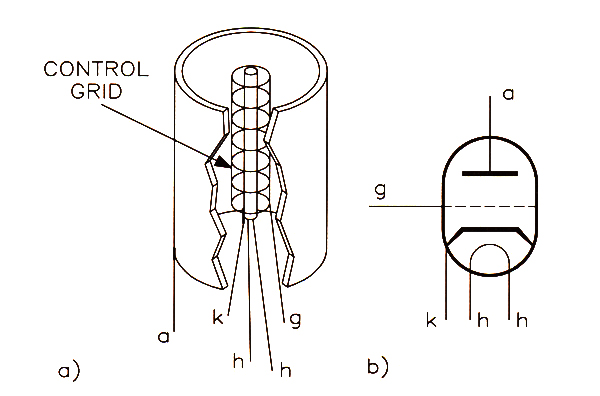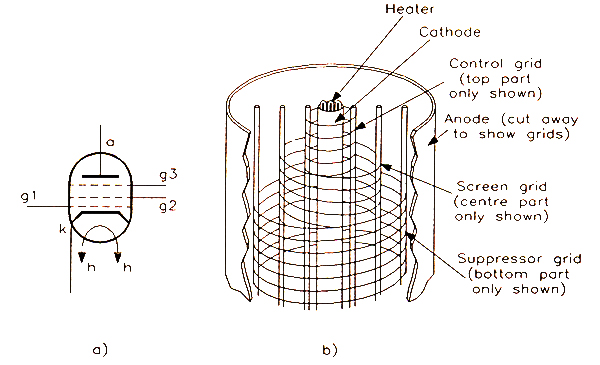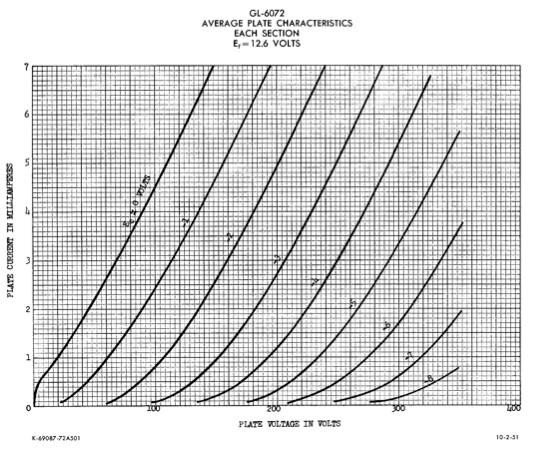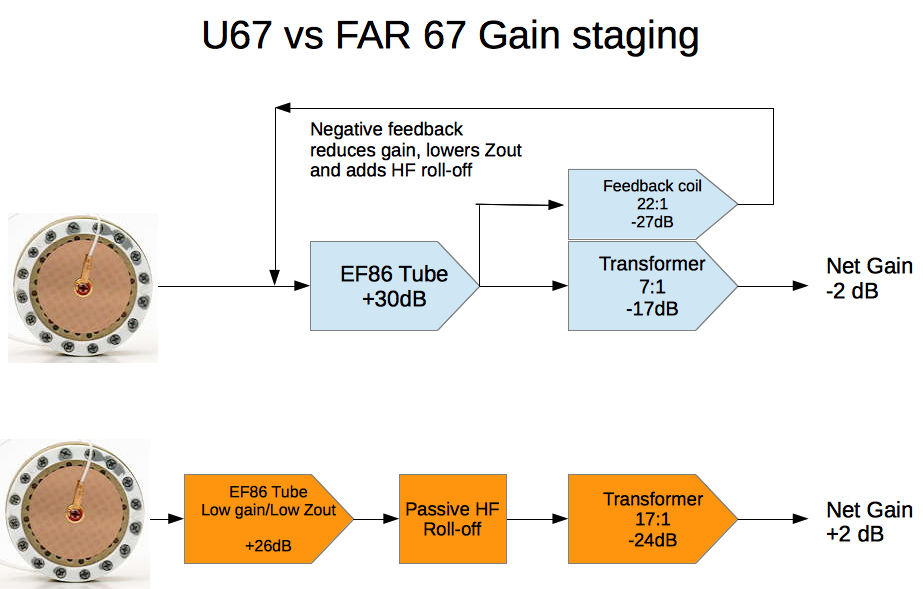The EF86 Tube

6072 vs EF86
After working with the P K67 capsule we turned our attention to the EF86 as a microphone preamp. The EF86 is of course the tube used in the u67. But there was some complicated design elements in the u67 so we had a challenge:
Could we create an equivalent mic preamp to the u67 without breaking the bank?
Hey it's a Pentode!
Right out of the gate the EF86 is a pentode not a triode like the 6072. Not ideal for a microphone. Very high output impedance and typically much higher distortion than a triode. But here's the fun part. Since the extra electrodes inside the EF86 all come out to a pin on the bottom of the tube, you are free to wire them up anyway you want!
Triode / Pentode Review
First lets look at the different parts of the triode both as a picture and as a schematic view.

Key to the parts of the triode
a = Anode, K=cathode, g= control grid, h = heater
In basic terms here is what happens in the Triode:
- The heater heats the cathode red hot (the little glowing thing you see inside the tube)
- The HOT cathode emits electrons, which have a negative charge
- Electrons are attracted across the vacuum inside the tube, to the Anode which has a high postive charge
- This causes a current of electrons to flow from the cathode to the anode in the vacuum
- The control grid is in the middle of the flowing current and so it can control the current by placing a voltage on it. A voltage more negative than the cathode will repel the electrons back to the cathode. If a high enough negative voltage is put on the control grid, the current can be made to almost completely stop
- So connect your input signal to the control grid and with a small voltage change it can "control" a fair amount of current going through the tube which is how you get amplification. (small voltage change creates big current change)
Now let's compare that to the big hairy monster Pentode

It's all the same as the triode with 2 additions:
Add the Screen Grid
- The screen grid was added to "screen" the control grid from the anode. This made a "Tetrode" (four "odes")
- This was done to reduce the capacitance that forms between the anode and the control grid. This capacitance has the effect of feeding the output back to the input (negative feedback) reducing gain the higher you go up in frequency
- This was a real problem for high frequency video and radio circuits
- The screen grid is charged positive like the anode so the electrons are attracted to it, but they fly right through the screen because it is porous and hit the anode
- This was done to reduce the capacitance that forms between the anode and the control grid. This capacitance has the effect of feeding the output back to the input (negative feedback) reducing gain the higher you go up in frequency
Side Effect!
In engineering there is no such thing as a free lunch. The Tetrode had new problems. These faster electrons hit the anode so hard that they knocked electrons out of the anode metal and this causes weird characterics in the tube (negative resistance!) (really)
Add the Supressor Grid
- Suppressor Grid was added to suppress this "secondary emission" of electrons now coming out of the anode that was caused by the screen grid!
- The suppressor grid is connected to the cathode and it is also right beside the anode. Any electrons that bounce out of the anode are repelled back towards the anode where they are re-captured
A more complete explanation of these things can be found at :
http://www.r-type.org/articles/art-010.htm
It turns out that if you connect the screen grid of the tube directly to the plate connection and connect the suppressor grid to the cathode as you normally would, you get a very good triode! The graph below shows the EF86 characteristics wired as a triode. This graph is comparing the Anode current (I a) at different anode and control grid voltages and they are quite normal for a triode.

For reference here are the characteristics of the 6072 out to 400 volts.
---
Which is Better 6072 or EF86
The plate resistance, a characteristic that affects the output impedance, of the EF86 wired as a triode is about 15K ohms. That compares to 20K for the 6072a. I like a tube with a lower output impedance for microphones. It let's you drive a higher ratio transformer , which gives more signal output, while at the same time maintaining a broad, low distortion response. So +1 for the EF86 there.
The amplification factor of the tubes is comparable, with the 6072 being only slightly higher. (44 times vs 34 times) This looks like alot, but it is only about 1 dB difference in decibels.
The EF86 is designed as a low noise preamp and so is the 6072 so we are pretty much even there. But this depends a great deal on the individual tube.
So all things considered, there is not a hands down winner here, but the EF86, triode wired, could be considered to be slightly ahead.
The u67 circuit
When we study the u67 circuit we see that it is using 210 volts on the plate circuit of the tube and a 150K ohm plate resistor. This 150K gives the circuit higher voltage gain. In fact it calculates to 30dB of gain. The bias is fixed at 1.3 to 1.6 volts according to the drawings and with that anode (plate) resistor the Plate output impedance (Zout) calculates to 13.6K ohms. If we were using a 6072 in these conditions the Zout would be 21K and the gain would be almost 38 dB.
The u67 output transformer is an interesting animal. For now let's consider just the output coil to keep it simple. The ratio on the transformer interestingly enough is about the same as a u47; 7:1.
A 7:1 turns ratio translates to a gain through the transformer of -17 dB (rounded up) So the overall u67 preamp gain should be :
(+30dB, tube) + (-17, trafo) = +13dB net gain
But when we read the specs from 1963 it says the internal preamp gain is -2dB. Why?
Negative feedback is the answer. By injecting 15dB of negative feedback they reduce the overall gain and that also lowers the output impedance so the little EF86 can drive that 7:1 transformer better.
"There's more than one way to skin a Cat"
So we changed things up a little. First we changed the way the circuit works. We are using a 120 volt power supply, so we had to adjust the amount of current flowing in the circuit and this had the side effect of lowering the gain and the output impedance. That's a step in the right direction!
Then we simply selected a transformer with a very high transformation ratio (17:1) which means our little EF86 tube is barely working hard. This gets the distortion WAY down without the need for negative feedback. And it also reduces the overall level of the output signal so it matches the u67 more closely.
Below is simplified view the u67 versus what we did.

So How did it work out?
We are pretty happy with the overall sound. Using the very high ratio transformer gives us a low distortion preamp. The sensitivity in cardiod is a little less than the u67 spec, due to the multi-pattern front end we have in our mic. But is it is consistent with the u67 figures for Omni and Figure 8. So in other words our design has pretty much even sensitivity in all polar patterns, where the u67 jumps 5dB in cardiod.
So I am pretty happy with it and I am keeping the prototype in our studio! Below is the sample recording as a podcast explaining this stuff, simul-recorded with a FAR 47.
Fox Audio Research 47 (Simul-recorded)
But it has wetted our appetite to make a negative feedback version... just for fun. :-)
If a microphone in the u67 style interests you send us a note to request a quote at:
